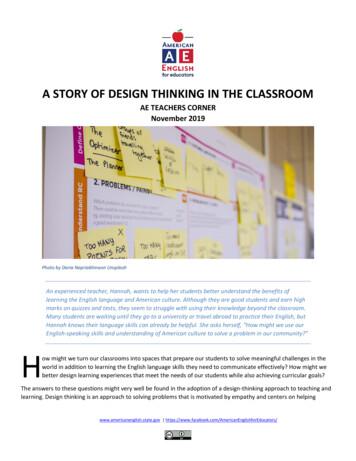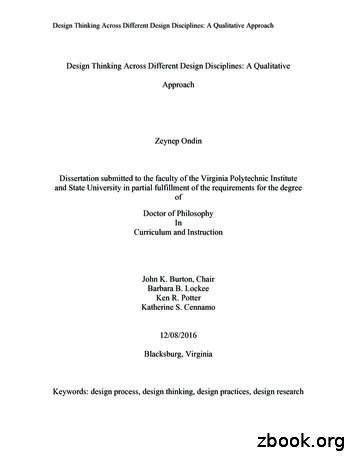Design Thinking Education: A Comparison Of Massive Open .
Cara Wrigley, The Design Lab, The University of Sydney, AustraliaGenevieve Mosely, The Design Lab, The University of Sydney, AustraliaMartin Tomitsch, The Design Lab, The University of Sydney, AustraliaDesign Thinking Education:A Comparison of Massive Open OnlineCoursesAbstract The popularity of design thinking is soaring, both as an approachto innovation and as a tool for non-designers seeking to gain a strategicedge over the competition. As more and more people take advantage ofMassive Open Online Courses (MOOCs) to bolster their skill sets, it comesas no surprise that design thinking courses have cropped up across variousdisciplines worldwide, in formal and informal educational settings. In thisarticle, we report on our research into design thinking courses availableto anyone online. Our study explored and categorized the different typesof design thinking MOOCs available in June 2017. It reveals the what (content), how (pedagogy and assessment), and why of online design thinkingcourses. The findings we discuss here can support design thinking education not only via the web, but also more generally.KeywordsDesign thinkingDesign educationMOOCEducational design ladderDesign innovationReceived February 26, 2018Accepted June 25, 2018EmailsCara Wrigley(corresponding author)Cara.wrigley@sydney.edu.auGenevieve Moselygenevieve.mosely@sydney.edu.edu.auMartin Tomitschmartin.tomitsch@sydney.edu.auCopyright 2018, Tongji University and Tongji University Press.Publishing services by Elsevier B.V. This is an open access article under theCC BY-NC-ND license ).The peer review process is the responsibility of Tongji University and Tongji University doi.org/10.1016/j.sheji.2018.06.002Design Thinking Education275
1 John Howard and HowardPartners, ACOLA SAF 10: SecuringAustralia’s Future—Capabilities forAustralian Enterprise Innovation:The Role of Government, Industry,and Education and Research Institutions in Developing InnovationCapabilities (Melbourne: AustralianCouncil of Learned Academies,2016), accessed July 2, 2018, https://acola.org.au/wp/PDF/SAF10/Howard.pdf.2 Gary W. Matkin, “Massive OpenOnline Courses: Looking Ahead byLooking Back,” Continuing HigherEducation Review 77, (2013):49–56, available at https://projects.iq.harvard.edu/cher/77/Matkin.3 Sandra Mulligan and GregorKennedy, “To What Degree?Alternative Micro-Credentialingin a Digital Age,” in Visions forAustralian Tertiary Education, ed.Richard James, Sarah French, andPaula Kelly (Melbourne: MelbourneCentre for the Study of HigherEducation, 2017): 41–53, accessedJuly 2, 2018, ary-Education.pdf#page 49.4 Cara Wrigley and Karla Straker,“Design Thinking Pedagogy:TheEducational Design Ladder,” Innovations in Education and TeachingInternational 54, no. 4 (2017):374–85, DOI: https://doi.org/10.1080/14703297.2015.1108214.5 Tim Brown, “Design Thinking,”Harvard Business Review 86, no.6 (2008): 84–92; Rodger Martin,The Design of Business: Why DesignThinking Is the Next CompetitiveAdvantage (Boston: HarvardBusiness Press, 2009).6 Horst W. J. Rittel and Melvin M.Webber, “Dilemmas in a GeneralTheory of Planning,” PolicySciences 4, no. 2 (1973): 155–69,DOI: https://doi.org/10.1007/BF01405730.7 Nigel Cross, “Designerly Ways ofKnowing: Design Discipline versusDesign Science,” Design Issues 17,no. 3 (2001): 49–55, DOI: https://doi.org/10.1162/074793601750357196.8 Neal Dreamson, “OnlineCollaboration in Design Education:An Experiment in Real-TimeManipulation of Prototypes andCommunication,” InternationalJournal of Art and Design Education36, no. 2 (2017): 188–99, tionIn today’s complex, connected digital age, individuals and organizations alike neednew tools and skills—entrepreneurial, business, management, leadership, creativity, design, and cross-cultural capacities1—that will enable them to strategizeand innovate sustainably. To meet the growing demand for such training, highereducation providers have begun to make specialized online courses available towider global audiences. Due to their flexibility, accessibility, and the breadth ofsubjects available, the popularity of these Massive Open Online Courses (MOOCs)has grown significantly over the last decade.2 MOOCs are adding to the emergenceof micro-credentialing, and enabling learners to supplement their degrees andprofessional practices with the skills that help them and their employers remaincompetitive in today’s shifting international markets and societies.3Creativity, design, cross-cultural sensitivity, and particularly design thinkingare learned by tertiary students in the sciences, arts, business, and medicine alike.4Beyond this emphasis in higher education, employers are also focusing on proficiency in these areas among their employees. Organizations from the public andprivate sectors alike are increasingly turning to design thinking5 to address wickedproblems.6 Recently, the notion of design thinking has shifted from design as ascience7 to design as a mindset and professional tool for non-designers to developas a skill.We need new learning approaches if we are to cultivate design thinking capability—and other twenty-first-century skills—in individuals whose expertise spansmultiple disciplines and practices. New technologies have led to new platforms andoutlets for online education of all kinds, including design.8 In addition to face-toface design thinking courses offered by higher education institutions, MOOCs areproviding such content to a wider audience online.9In this article, we will explore how educators are teaching design thinkingonline to a general and diverse audience. We found a broad range of designthinking MOOC applications. Seven key themes emerged, whose content and pedagogical approaches we will discuss and assess.Design Thinking EducationDesign thinking has gained notoriety across various disciplines because its toolsand methods are often associated with innovation.10 Universities are increasinglyincorporating design thinking into their curricula as a result.11 Long-establishedcomponents of any design discipline curriculum, design thinking courses arebecoming common in business and management education.12 Design thinkingcourses often ask cohorts of students from a variety of disciplines—engineering,social sciences, medicine, and education, for example—to solve real, complex problems using a human-centered design approach.13 In addition to promoting transdisciplinary creative thinking and collaboration, enabling cross-disciplinarity amongstudents can bridge specific gaps in knowledge.14Cara Wrigley and Karla Straker’s15 study of undergraduate design thinkingcourses forms the foundation for their Educational Design Ladder, a scaffold for thedesign and progression of design thinking courses within a multidisciplinary context (Figure 1). The ladder reveals that, for design thinking to be successfully taughtwithin higher education contexts across multiple disciplines, “design projectsshould involve authentic, hands-on tasks; possess clearly defined outcomes thatallow for multiple solutions; promote student-centered, collaborative work andhigher order thinking” as well as enable multiple design iterations.16The undergraduate Educational Design Ladder demonstrates that the content and pedagogical stages of design thinking must progressively increase inshe jiThe Journal of Design, Economics, and InnovationVolume 4, Number 3, Autumn 2018
Higher OrderThinking Skills54Business ct Level2KnowledgeDimensionSOLOTaxonomyDesignThinking LevelLower OrderThinking SkillsProduct ion alyzeDeconstructingDifferentiatingOrganizingFigure 1 The EducationalDesign Ladder. Adapted fromWrigley and Straker, “DesignThinking Pedagogy,” 381.Copyright 2017 Cara Wrigleyand Karla SelectingMETACOGNITIVEStrategic knowledgeof cognitive tasksand self-knowledgePROCEDURALKnowledge ofspecific skills,techniques, andmethodsCONCEPTUALKnowledge ofclassifications andcategories, principlesand generalizationsCONCEPTUALKnowledge ofclassifications andcategories, principlesand generalizationsFACTUALKnowledge ofterminology, specificdetails, and elementscomplexity—from lower order to higher order thinking skills, and from a foundational level of application to a professional one—for students’ notional understanding of design thinking and their practical skills to develop apace. Materialbegins with the basic product level and gradually moves through the project, business, and professional levels—with activities, subjects, learning modes, and assessment developing across each step. They state that pedagogy moves from lecturesand tutorials, through to collaborative design projects, workshops, and studioclasses on industry projects and work integrated learning.17Design is predominantly taught through studio-based practice, which raisesthe question of how design thinking can be taught online and from a distance.Virtual design studios (VDS) emerged in the early 1990s, primarily for architecturaldesign education.18 A VDS is a networked design studio that allows students invarious locations to “generate, communicate, and implement design ideas.”19 In hisstudy of VDS, Thomas Kvan20 notes that teaching design online creates numerousopportunities to reconsider teaching methods traditionally employed in face-to-facesettings, and allows instructors, teachers, and facilitators to develop and adapt tonew ways of teaching and learning.Ji-Yong Park suggests that for design education to be effective through anonline platform, it needs to have “an integrated framework of design learning,including an interactive communication structure and learning evaluation.”21Along these lines, The Open University course “U101 Design Thinking: creativity forthe 21st century”22 is delivered as an online learning module that includes a VDS.As Peter Lloyd observes, the course enables diverse groups of students to acquiredesign thinking skills that “can be directly applied to a business context” as well asDesign Thinking Education9 Mana Taheri and ChristophMeinel, “Pedagogical Evaluationof the Design Thinking MOOCs,”in Proceedings of the 3rd International Conference for DesignEducation Researchers, vol. 1, ed.Robin Vande Zande, Erik Bohemia,and Ingvild Digranes (Aalto:Aalto University School of Arts,Design, and Architecture, 2015):469–81, available at esign-education-researchers/; Mana Taheri,Thomas Unterholzer, and Christoph Meinel, “Design Thinking atScale: A Report on Best Practiceof Online Courses,” in DesignThinking Research: UnderstandingInnovation, ed. Hasso Plattner,Christoph Meinel, and Larry Leifer(Cham: Springer InternationalPublishing, 2016), 217–35, DOI:https://doi.org/10.1007/978-3-31940382-3 13.10 Andy Dong, “Design Innovation: Perspective or EvidenceBased Practices,” InternationalJournal of Design, Creativity andInnovation 3, no. 3-4 (2015):277
148–63, DOI: https://doi.org/10.1080/21650349.2014.943294.11 Judy Matthews and CaraWrigley, “Design and DesignThinking in Business and Management Higher Education,”Journal of Learning Design 10, no.1 (2017): 41–54, DOI: https://doi.org/10.5204/jld.v9i3.294; GavinMelles, Zaana Howard, and ScottThompson-Whiteside, “TeachingDesign Thinking: ExpandingHorizons in Design Education,”Procedia—Social and BehaviouralSciences 31, (2012):162–66,DOI: https://doi.org/10.1016/j.sbspro.2011.12.035; Wrigley andStraker, “Design Thinking Pedagogy,” 374–85; Andrew Withell andNeil Haigh, “Developing DesignThinking Expertise in HigherEducation,” in Proceedings of the2nd International Conference forDesign Education Researchers,ed. Janne Reitan et al. (Oslo:ABM Media, 2013), 1–8, availableat MULUS-Oslo-2013-Proceedings.12 Matthews and Wrigley, “Designand Design Thinking,” 41–54.13 Wrigley and Straker, “DesignThinking Pedagogy,” 374–85.14 Rim Razzouk and ValerieShute, “What is Design Thinkingand Why Is It Important?,” Reviewthe wider world.23 The potential benefit of teaching design thinking online, according to Lloyd, is that it facilitates interactivity and collaboration among a multidisciplinary cohort.Few scholars have explored the effectiveness of teaching design thinking inan online environment in depth. Mana Taheri and Christoph Meinel24 chose fourintroductory-level design thinking MOOCs in their study of desirable learningobjectives in design thinking education. Their aim was twofold: to evaluate howeach course fulfilled an established pedagogical framework and to determine whatspecific educational and technological practices underpin best practice MOOCs.25To assess the four courses, Taheri and Meinel sought to determine whether eachfulfilled Arthur Chickering and Zelda Gamson’s26 seven principles for good practicein undergraduate education. These are 1) encourage contact between students andfaculty; 2) foster cooperation between students; 3) promote active learning; 4) provide prompt feedback; 5) emphasize time on tasks; 6) communicate high expectations; and 7) respect and support diverse talents and ways of working. The scholarsconcluded that, although teaching design thinking online has its challenges,adhering to these seven principles will ensure that MOOCs will deliver a high standard of teaching and learning.From this investigation, Mana Taheri and her colleagues developed a designthinking MOOC prototype to explore how design thinking can be taught online toa massive and diverse audience.27 Applying Kurt Kraiger, Kevin Ford, and EduardoSalas’s view on cognitive, skill-based affective learning outcomes28 to specificdesign thinking outcomes such as creative confidence29 or a design thinkingmindset,30 the scholars created a conceptual model for design thinking learningoutcomes. They used this as the basis for their construction of a prototypical designthinking MOOC (Figure 2).The prototype MOOC results revealed that incorporating exercises and peer-reviewed learning encouraged participants to transfer gained knowledge while alsodeveloping collaborative learning outcomes.31 The results, however, do not explicitly state if MOOC participants achieved all three learning outcomes as highlightedin the conceptual model.Figure 2 Conceptual Modelof Design Thinking Outcomes.Adapted from Taheri et al., “TheDT MOOC Prototype,” 220.Copyright 2018 Cara Wrigley,Genevieve Mosely, and uralizationCompositionAutomaticityDesign ThinkingLearning OutcomeQUALITATIVEINTERVIEWSCOGNITIVEOUTCOMEVerbal KnowledgeAttitudinalKnowledge OrganizationCognitive StrategiesMotivationalMotivational DispositionsSelf-efficacyGoal SettingDesign ThinkingLearning OutcomeDesign ThinkingLearning OutcomeHUMANCENTEREDMINDSET278she jiAFFECTIVEOUTCOMEThe Journal of Design, Economics, and InnovationCREATIVECONFIDENCEVolume 4, Number 3, Autumn 2018
Massive Open Online CoursesIn 2016, MOOC platforms had fifty-eight million students, with over seven hundred partner universities offering 6,580 courses.32 MOOCs serve large numbers ofstudents and provide a combination of open online courses, short video lectures,automated assessments, quizzes, peer and self-assessment, and student collaboration through forum discussions.33 The University of Manitoba was the first to describe an open online course experiment utilizing connectivism as a “MOOC.”34 Theacronym was similar to other online platforms emerging at the time, such as MultiUser Dimensions (MUDs), MUD object-oriented (MOOs), and Massively MultiplayerOnline Role-Playing Games (MMORPGs).35 MOOCs enable individuals to participatein education, professional development, and upskilling at the time, pace, and placeof their choice. As Rolin Moe states, MOOCs were envisioned as opportunities forlearners to engage in “a unique geospatial environment of content and connections, a marked departure from the formalized and accredited nature of traditional higher education.”36 MOOCs can be delivered using centralized platforms(Coursera, edX; learning management systems) and decentralized networks (blogs,social media) and are designed to supplement university courses, professional development modules, and corporate training programs.37MOOC learning design and pedagogical strategies vary significantly. Thereare two main types: cMOOCs and xMOOCs.38 cMOOCs are based on connectivistlearning theory—learning experiences are designed to be networked, open, and decentralized, and the learner determines their objectives, processes, and outcomes.39xMOOCs are based on cognitive-behaviorist theory—learning is centrally controlledand instructor directed, designed, and structured. The majority of today’s MOOCsare based on xMOOC principles, as their modes of delivery typically follow a moretraditional structure: all students enrolled move through the course together, andcontent is taught by experts in that field. But in recent years the format of MOOCshas shifted towards greater accessibility. MOOCs—originally modeled on university courses—used to follow semester timetabling and have assignment deadlines.As course providers learned more about online student behaviors, MOOCs havebecome more student centered by offering self-paced courses with soft assignmentdeadlines.40 This kind of personalized learning experience has drawn more students to online courses. However, because students learn in smaller cohorts and attheir own pace, the collective learning experience happening in online discussionforums and through peer assessments, for example, is also being impacted.Students use MOOCs to attend video lectures, read texts, participate in discussion forums, complete quizzes, and perform peer assessments. Discussion forumsplay an essential role in MOOCs, as tutors do not provide ongoing support. Students, therefore, need to collaborate and learn through peer-to-peer informationexchange and assessment.41 Sandra Mulligan and Patrick Griffin’s42 investigationinto how students learn in MOOCs, and the implications of this for MOOC design,revealed that learners can be classified on a continuum from novice to expert,and that learners at each stage will have personal attitudes, knowledge, skills, andbeliefs about learning.To better understand more specific approaches to design thinking MOOCs, ourstudy looks at which aspects of design thinking they teach, and how they deliverdesign thinking curricula on English speaking learning platforms worldwide. Wealso compare design thinking MOOCs with existing design thinking educationframeworks and models.of Educational Research 82, no. 3(2012): 330–48, DOI: https://doi.org/10.3102/0034654312457429.15 Wrigley and Straker, “DesignThinking Pedagogy,” 374–85.16 Wrigley and Straker, “DesignThinking Pedagogy,” 383.17 Ibid.18 Jeremy J. Ham and Mark AurelSchnabel, “Web 2.0 Virtual DesignStudio: Social Networking asFacilitator of Design Education,”Architectural Science Review 54,no. 2 (2011): 108–16, DOI: s Kvan, “The Pedagogy of Virtual Design Studios,”Automation in Construction 10, no.3 (2001): 345–53, DOI: https://doi.org/10.1016/S0926-5805(00)000510.19 Mary Lou Maher, SimeonSimoff, and Anna Cicognani, ThePotential and Current Limitationsin a Virtual Design Studio (Sydney:Key Centre of Design Computing,University of Sydney, 1996).20 Kvan, “The Pedagogy of VirtualDesign Studios,” 345–53.21 Ji Yong Park, “Design Education Online: Learning Deliveryand Evaluation,
Design Thinking Education Design thinking has gained notoriety across various disciplines because its tools and methods are often associated with innovation.10 Universities are increasingly incorporating design thinking into their curricula as a result.11 Long-established components of any design discipline curriculum, design thinking courses are
12. LEARNING DESIGN APPROACHES FOR BUILDING DESIGN THINKING SKILLS 190 11.1 DEPLOYING DESIGN THINKING IN BUSINESS AND IN EDUCATION 190 11.1.1 Design thinking in business 190 11.1.2 Design thinking in education 191 11.1.3 Design thinking in teaching and learning through ICT 193 11.2 PROBLEM-BASED LEARNING (PBL) 193
people. In this article you will learn the essential qualities of a design thinking mindset, the distinctions between design thinking, design processes and designed products, and two ways to bring design thinking into your work with students. Design Thinking Vs Design Process Vs Designed Product Any Internet search for "design thinking" will .
Vive un proceso de diseño en primera persona DESIGN THINKING Curso de Design Thinking Haz Design Thinking. Sumérgete en procesos de innovación reales. . DESIGN THINKING ¿Contenidos? Diferentes lienzos y técnicas de síntesis de la información obtenida en la fase de investigación: mapa de empatía, perfil
Design Thinking work and be effective in the banking sector is an open question. DESIGN THINKING VERSUS TRADITIONAL BUSINESS THINKING We will put forward what we believe are the key differences are between Design Thinking and traditional business thinking. Broadly, these differences can be grouped into three main categories:
Design Thinking Across Different Design Disciplines: A Qualitative Approach Design Thinking Across Different Design Disciplines: A Qualitative Approach Zeynep Ondin ABSTRACT Even though disciplines that are not traditionally affiliated with design have started to show interest in design thinking such as business, education, healthcare,
Critical Thinking Skills vs. Critical Thinking Disposition Critical Thinking Skills are the cognitive processes that are involved in critical thinking Critical Thinking Disposition is the attitudes, habits of mind or internal motivations that help us use critical thinking skills.
The Role of Critical Thinking in Problem Analysis Brian D. Egan, M.Sc., MBA, PMP Introduction Contrary to what the name implies, critical thinking is not thinking that is critical of others. It is “fundamental” or “vital” thinking. Critical thinking is thinking that drills down to the essence of a problem. It is introspective
Asset Management is increasingly well understood by the business community as a strategic and business led discipline, where the value of assets is their contribution to achieving explicit business objectives. If you are encountering Asset Management for the first time, this book should be a helpful introduction to the key topics. It should also highlight the benefits which are there to be .























